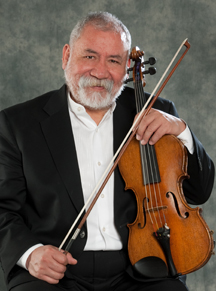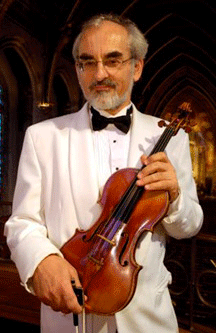Chamber Music Concert Features Strings and Oboe Quartet
March 13, 2018
Willy Sucre and Friends will close out this season’s Presidential Chamber Music Series with a “Strings and Oboe” quartet at 7:30 p.m. Monday, March 26, at New Mexico Tech’s Macey Center.

SOCORRO, N.M. – Willy Sucre and Friends will close out this season’s Presidential Chamber Music Series with a “Strings and Oboe” quartet at 7:30 p.m. Monday, March 26, at New Mexico Tech’s Macey Center.
Sponsored by New Mexico Tech President Stephen G. Wells and Socorro Springs, and under the umbrella of the University’s Performing Arts Series (PAS), this classical music concert is free to all.
Oboe and Strings is the fourth and final concert for the 2017 – 2018 chamber music series. Violist Sucre, the face of the series since its inception, will be joined at Macey Center by Robert Ingliss on oboe, Krzysztof Zimowski on violin, and James Holland on cello.
The evening’s program features "Oboe Quartet in F Major KV 370" by Mozart, "Phantasy Quartet Op. 2. (1932)" by Britten, "Duo for Violin and Oboe No. 1 in D Major" by Telemann, and "Quartet No. 6 Op. 4 in D Major" by Karl Stamitz.
“It is customary for Willy to close out the chamber music series each spring with a program suited for the season, and this year is no exception,” said PAS Director Ronna Kalish.
Enjoy a wine tasting sponsored by Tech Club Macey starting at 5:30 p.m. and featuring local oenophile Bill Stone of New Mexico Tech. Admission is $10 for members, $15 for non-members. A selection of wines sold in Socorro will be served with prosciutto, capacollo and salami, with crackers and brie, Gouda and cheddar cheeses.
 The Oboe Quartet in F Major was written by Wolfgang Amadeus Mozart (1756 – 1791) in
early 1781, after the German composer renewed an acquaintance with Friedrich Ramm,
a virtuoso oboist in the Munich orchestra.
The Oboe Quartet in F Major was written by Wolfgang Amadeus Mozart (1756 – 1791) in
early 1781, after the German composer renewed an acquaintance with Friedrich Ramm,
a virtuoso oboist in the Munich orchestra.
Program notes indicate that Mozart wrote the quartet to showcase improvements made to the woodwind instrument at the time. Indeed, the composition remains one of the notable classical works featuring the oboe.
The piece features three movements: I. Allegro, II. Adagio and III. Rondeau: Allegro. The main theme is expressed in the first movement, as played by the oboe in the opening bars, and requires a certain level of virtuosity on the part of the oboe. It is said that the composition almost resembles a concerto, but with only four musicians. Listen for the well-known 13-bar passage in the finale which requires ensemble playing.
From the late 18th century, the concert journeys to 1932, when Benjamin Britten (1913 – 1976) wrote “Phantasy Quartet Op. 2.” Britten is generally regarded as one of the most prominent composers of the 20th century for having earned the admiration of his contemporaries. His music covers a wide range of musical genres.
Britten wrote the Phantasy Quartet specifically for a “phantasy competition” while he was a student at the he was attending the Royal College of Music, and dedicated it to the legendary British oboist Leon Goossens.
(“Phantasy,” as used in the Phantasy Quartet, dates back to the 16th and 17th centuries; it is the old-English spelling of “fantasia.”)
The piece features four movements: I. Andante alla Marcia, II. Allegro giusto, III. Con fuoco, IV. Tempo I - Andante alla Marcia. As in Mozart’s Oboe Quartet, the oboe dominates the ensemble. At the climax of the development section, the pace slackens, followed by a slow, pastoral section before the oboe rejoins its
Georg Philipp Telemann (1681 – 1767)’s “Oboe Quartet No. 1 in D Major,” with its four movements, follows a brief intermission: I. Dolce, II. Allegro, III. Grave and IV. Allegro. Telemann, a German Baroque composer and multi-instrumentalist and one of the most prolific composers in history, was considered by his peers to be one of the leading German composers of the time; his music is an important link between the late Baroque and early Classical styles.
Closing out the evening of Oboe and Strings is Oboe Quartet No. 6 in A Major, Op. 14/6 by Carl Stamitz (1745 – 1801). It is performed in three movements: I. Allegro poco moderato, II. Romance and III. Allegro. Stamitz, who changed his given name from Karl, was a German composer of partial Czech ancestry and the most prominent representative of the second generation of the Mannheim School.
Stylistically, Stamitz's music is not too far removed from the works of the young Mozart, or those of Haydn's middle period. Stamitz's works are characterized by regular periods and appealing melodies. This composition, one of his six quartets, was written in 1776.
Let’s meet the musicians: Robert Ingliss is principal oboe of the New Jersey Symphony and The Santa Fe Opera orchestras. He tours worldwide with the Orpheus Chamber Orchestra, with whom he has appeared as soloist, and is a member of An die Musik, Cygnus Ensemble, and Manhattan Sinfonietta.
An avid proponent of contemporary music, he has premiered works by Milton Babbitt, Elliott Carter, Marc-André Dalbavie, and many others. His recording credits and performances on soundtracks for film and television are as varied as they are numerous. He has taught at Columbia University, Sarah Lawrence College, and SUNY/Purchase.
 Violinist Krzysztof Zimowski (pictured at right) is currently concertmaster of the
New Mexico Philharmonic and Opera Southwest Orchestra. For more than a decade, he
was the concertmaster and featured soloist of the former New Mexico Symphony Orchestra.
Born in Wroclaw, Poland, he began his musical studies at the age of six. In 1977 he
received his master's degree with honors from the Academy of Music in Wroclaw.
Violinist Krzysztof Zimowski (pictured at right) is currently concertmaster of the
New Mexico Philharmonic and Opera Southwest Orchestra. For more than a decade, he
was the concertmaster and featured soloist of the former New Mexico Symphony Orchestra.
Born in Wroclaw, Poland, he began his musical studies at the age of six. In 1977 he
received his master's degree with honors from the Academy of Music in Wroclaw.
In 1985 he was appointed concertmaster of that orchestra and toured Europe, South America, and the United States. He moved to New Mexico in 1986 to help form the Helios String Quartet, the ensemble-in-residence of the Placitas Artists Series until 1997. Zimowski lives in Albuquerque with his wife, Urszula, also a musician.
Cellist Ian Jones is a native of Oakland, California. He attended UCLA and Indiana University, continuing at IU for studies with Eric Kim and Janos Starker. For the 2006-07 concert season, Ian joined the cello section of Honolulu Symphony. In 2008 his string quartet was awarded the school-funded Kuttner Quartet fellowship at IU. He has benefited from close collaboration and coaching with Indiana faculty members including Atar Arad, Alexander Kerr, Paul Biss and Yael Weiss, and has collaborated onstage with Joshua Bell and members of the Orion Quartet among others.
Ian joined the Tucson Symphony Orchestra in 2011, where he was recently appointed assistant principal cello. He earned his master’s degree in performance in 2013 studying with Mark Votapek. For the past three years he has appeared in the Breckenridge Music Festival’s Winter Concert Series, and for the summer of 2014 joined the BMF for their regular summer concert season. An avid tennis player, Ian competes in local USTA leagues in Tucson and the San Francisco Bay Area.
Violist Willy Sucre is a member of the New Mexico Philharmonic and the driving force behind the "Willy Sucre & Friends" concerts. Born in La Paz, Bolivia, Sucre studied at the Conservatorio Nacional de Música in La Paz, Colby College Chamber Music Institute in Waterville, Maine, Mannes School of Music in New York, and the Peabody Conservatory in Baltimore,Maryland.
Sucre spends most of his summers in South America looking for new works of chamber music by modern composers and encouraging composers to write new pieces, especially piano quartets. He enjoys performing with ensembles of diverse instrumentation.